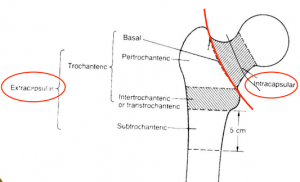Trochanteric femur fracture
Background
- Greater trochanter
- Caused by direct trauma (older patients) or avulsion injury (adolescents)
- Lesser trochanter
- Avulsion due to forceful contraction of iliopsoas (adolescents) or pathologic bone
Clinical Features
- Greater Trochanter
- Hip pain that increases with abduction; tenderness over greater trochanter
- Lesser Trochanter
- Patients usually ambulatory
- Pain in groin worse with flexion, or patient has difficulty lifting leg at hip from seated position (iliopsoas insufficiency)
Differential Diagnosis
Proximal
- Intracapsular
- Extracapsular
Evaluation

Location of femur fractures
- Consider AP pelvis in addition to AP/lateral views to compare contralateral side
- Consider MRI if strong clinical suspicion but negative x-ray
Management
General Fracture Management
- Acute pain management
- Open fractures require immediate IV antibiotics and urgent surgical washout
- Neurovascular compromise from fracture requires emergent reduction and/or orthopedic intervention
- Consider risk for compartment syndrome
Specific Managment
Disposition
- Outpatient
- Non-weight bearing with ortho follow up in 1-2 weeks (for both types)
See Also
External Links
References
This article is issued from
Wikem.
The text is licensed under Creative
Commons - Attribution - Sharealike.
Additional terms may apply for the media files.